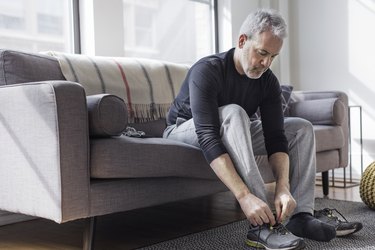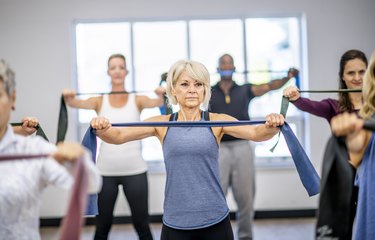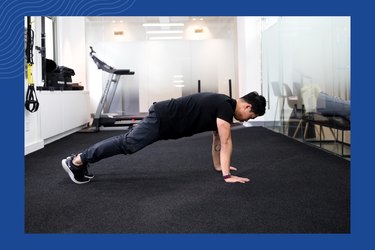
With all the benefits that come with dropping pounds when you're overweight — improved blood pressure, more energy and lower risk of disease, to name just a few — it may be surprising to learn that there can be disadvantages, too.
True, there aren't many, as long as you're taking a safe, slow-and-steady-wins-the-race approach. But even then, losing weight can come with one major downside, especially for older people: bone loss, according to a December 2019 study published in the Journal of Bone and Mineral Research.
Video of the Day
Video of the Day
And as bone density decreases, the risk of falling and major injuries increase, says Geoff Tripp, CSCS, certified personal trainer and head of fitness at Trainiac — and these injuries could have major consequences for your quality of life. "In older populations, a severe fall could mean the loss of functionality," Tripp says.
Fortunately, there's a way to drop pounds and protect your bones at the same time. The study also found that resistance exercise, alone or combined with aerobic exercise, is an effective way for older adults to maintain bone density while following a weight-loss regimen.
Read more: 5 Simple Ways to Stop Age-Related Weight Gain

How Does Resistance Training Bolster Bone Health?
"Bone adapts to stress that is placed on it," says Tripp. Through compression forces, resistance exercises place stress on your bones and your tendons (which tug and pull on your bones). The result: "The combination of compression and the tug-pull effect stimulates bone-producing cells (osteoblasts and osteocytes) to lay down new, stronger bone," Tripp says. In other words, strength training improves your bone density and mass by creating and preserving healthier bones.
So, how often should you do resistance-based exercises? "Generally, people of all ages should perform resistance exercise two to four times per week to maintain and improve bone density and muscle mass," says Tripp.
His recommendation is in line with the Department of Health and Human Services' Physical Activity Guidelines for Americans, which encourage adults to do muscle-strengthening activities of moderate or greater intensity that involve all major muscle groups on two or more days a week. The guidelines also say that adults should get in at least 150 minutes of moderate-intensity or 75 minutes of vigorous-intensity aerobic exercise each week.
Resistance-Exercise Workout for Weight Loss
If you're ready to boost your bones and shed some pounds, try incorporating this resistance-based routine, designed by Tripp, into your weekly workout regimen. All you'll need is a resistance band, some dumbbells and a stability ball.
Before you dive in, keep this format in mind:
- Start with three to five minutes of dynamic stretching to warm up your muscles
- Perform each move for 10 to 12 reps
- Rest for 30 seconds between each move
- Repeat the circuit two times total, resting for 1 minute in between rounds
- Cool down with a series of static stretches
Resistance Band T-Pulls
- Grip a long, light resistance band at both ends with arms in front of you at shoulder height.
- Keep your arms relatively straight and squeeze your shoulder blades together as you move your hands out to the sides, pulling the band toward your chest.
- Return to the starting position slowly and with control.
Lateral Band Walk
- Loop a resistance band just above your knees.
- Keep your feet hip-width apart as you take 10 small steps to the side, engaging your hip muscles.
- Repeat on opposite side.
Dumbbell Ys and Ts
- Hinge at your hips, lean forward and keep your back flat.
- Holding a light pair of dumbbells (thumbs facing up), lift both arms above your head forming the letter "Y".
- Next, bring your arms out to your sides to form the letter "T."
- Return to the "Y" position, then back to your starting position.
Plank Holds
- Start lying on your stomach, hands under your shoulders and feet flexed, toes pressing into the ground.
- Push through your hands and toes as you lift yourself up so that your arms are fully extended and your body is in a straight line from head to toes.
- Tighten your core and keep your hips from sagging.
- Hold for 10 seconds, then rest for two. Repeat three times for one set.
Floor Glute Bridge
- Start by lying on your back.
- Place your heels on the ground with your knees bent to 90 degrees.
- Tuck your pelvis, engage your core and drive through your heels as you lift your hips up.
- Squeeze your glutes at the top of the movement, then slowly lower to starting position.
Split Squats
- Start in a staggered stance.
- Slowly lower into a lunge, bending both knees to 90 degrees.
- Keep your chest up and your front knee behind your toes as you drive through your feet to stand.
- Repeat for 10 to 12 reps, then switch to the opposite leg.
Stability Ball Hamstring Curl
- Lie flat on your back and place both feet on top of a stability ball.
- Dig your heels into the ball and pick your hips up.
- Slowly pull the ball in towards your hips using your hamstring and calf muscles.
- Keep your core engaged to maintain balance, then extend your legs, pushing the ball back to starting position.
Dumbbell Curl to Press
- Grab a pair of moderately heavy dumbbells and hold them at your sides.
- Flexing your elbows, curl the weight upward in a controlled motion.
- Then rotate your palms outward and press the dumbbells overhead until your arms are straight.
Dumbbell Tricep Kickback
- Grab a pair of moderately heavy dumbbells (palms facing your body) and hold them at your sides.
- Hinge forward at your hips, keeping core pulled in and your back straight.
- Bend your arms 90 degrees at the elbow so your triceps are aligned with your back.
- Lift the dumbbells up and back as you straighten your arms.
- Pause briefly at the top contraction, then lower the dumbbells back down to the starting position.
- Centers for Disease Control and Prevention: “Losing Weight
- Journal of Bone and Mineral Research: “Effect of Aerobic or Resistance Exercise, or Both, on Bone Mineral Density and Bone Metabolism in Obese Older Adults While Dieting: A Randomized Controlled Trial.”
- Mayo Clinic: “Bone health: Tips to keep your bones healthy.”
- Department of Health and Human Services: "Physical Activity Guidelines for Americans"
